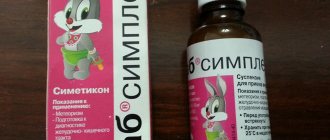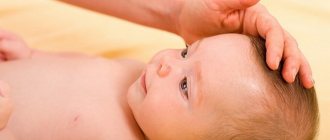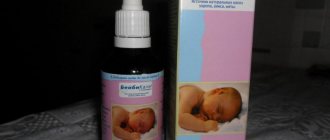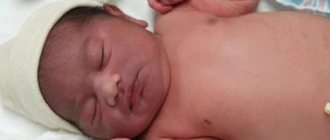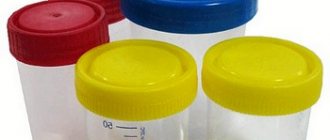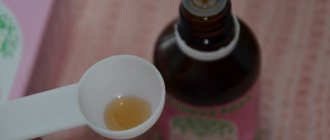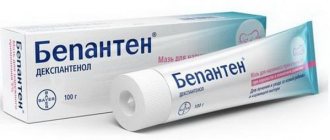Jaundice in newborns: why did my baby turn yellow?
For the sake of your maternal peace of mind, let us repeat: the fact that your newborn baby suddenly turned orange on the second or third day of life should in no way make you nervous or frightened.
Jaundice in newborns is not a disease! This is just an indicator (a kind of marker) of certain physiological processes that occur in the child’s body due to his “moving” from the mother’s womb into the light of day. In order to understand exactly how a newborn’s skin changes color from romantically pink to hysterically yellow, it makes sense to recall some paragraphs from a school anatomy course:
The mechanism of jaundice. In human blood there are special red blood cells - erythrocytes, whose task is to carry oxygen and carbon dioxide throughout the body. Every day, approximately 1% of all red blood cells that rush through our body die (the lifespan of each red blood cell is no more than 120 days). When these cells collapse, they release a substance contained inside red blood cells - bilirubin - a special yellow pigment that is actively involved in hemoglobin metabolism. Bilirubin itself is a rather dangerous and toxic substance for internal organs, so normally, as soon as the blood brings it to the liver, it is immediately neutralized by special liver enzymes. In medical language, the process of neutralizing the harmful yellow pigment in the liver is called “bilirubin conjugation.” The neutralized bilirubin then passes through the bile ducts and is eliminated from the body by the excretory system.
If any link in this chain of formation and excretion of bilirubin is disrupted, the level of this substance increases, the yellow pigment penetrates the skin, coloring the face and body in “autumn tones.” And if we were talking not about newborns, but about older people, then we should consider jaundice as an obvious symptom of a serious disease (for example, liver disease like hepatitis, acute poisoning, intoxication, inflammation of the gallbladder, stagnation of the bile ducts, etc. .).
Bilirubin norms by age
Bilirubin is a bile pigment formed as a result of the destruction of proteins - hemoglobin, myoglobin, cytochrome. The process occurs in the liver, spleen, and bone marrow. Exceeding threshold values may indicate increased destruction of red blood cells, or failure of excretion from the body as a result of pathology. In a newborn, a test for bilirubin levels is taken from the umbilical cord immediately after birth.
The bilirubin levels of a newborn and an adult are different. The table presents age characteristics.
| Age | Norm, micromoles per liter |
| Days from birth | 34 or less |
| Two days | 24-149 |
| From three to five days | 26-205 |
| From five days to sixty years | 5-21 |
This is interesting: Obstructive jaundice: causes, symptoms, diagnosis and treatment
The indicator can increase to 256 micromoles, 324 is considered an alarming signal. For premature infants, the norm is lower. Doctors become concerned at levels of 150-250 micromoles.
Physiological jaundice in newborns is within normal limits
But jaundice in newborns is most often a physiological norm. The bottom line is that a child, barely born, has a very high level of hemoglobin, which begins to decline sharply in the new conditions of the baby’s life. In addition, a newborn baby has a not yet fully formed “army” of liver enzymes. In other words, in the first days of life, the newly born baby is simply physically unable to cope with the high level of bilirubin in her blood. That is why the baby is rapidly turning yellow.
At least 60% of absolutely healthy full-term newborn babies turn yellow on the second or third day of life. This is normal and does not threaten the child with any harm. In medicine there is even a term - physiological jaundice of newborns. Physiological means natural, normal, without pathology.
So, even if you are in this 60%, there is no reason to be afraid. And if it happens that the child was born premature (which means that he has even fewer capable liver enzymes than a healthy toddler), then you have an even greater chance of admiring his yellow color - 80-90% of all babies born prematurely , experience physiological jaundice of newborns.
]premature babies[/anchor] at risk for jaundice in newborns are babies whose mothers have diabetes, as well as twins (twins, triplets, etc.)
Normally, jaundice in a newborn baby should go away within two to three weeks. But what to do in cases where the child turns yellow naturally, but doesn’t seem to be going back to pink, even after three weeks?
Types of disease
The process of bilirubin formation begins with the breakdown of fetal hemoglobin and the formation of regular hemoglobin. It is up to the liver to get rid of the result of this process, which is poorly developed in children who have just been born. Excess bilirubin causes the liver to become very busy, and it cannot cope with its processing and elimination.
Initially, jaundice is divided into physiological and pathological. The first is not considered a deviation from the norm, but is considered an adaptation of the newborn organism to the outside world. It manifests itself in the first 3 days of the baby’s life and, without any intervention, completely disappears by the 10th day.
With physiological jaundice there are no deviations:
- the child’s development is normal;
- a good appetite;
- deep sleep;
- feces and urine are the correct color.
Pathological jaundice is characterized by:
- manifestation on the first day of a baby’s life;
- rapid increase in bilirubin on day 4;
- duration of the period is more than 3 weeks;
- temperature increase;
- deterioration of general condition;
- changes in stool and/or urine.
There is also a type of jaundice that occurs against the background of obstruction of the bile ducts.
It is called mechanical, and is characterized by:
- dry and itchy skin;
- the child is too restless;
- stool becomes discolored;
- urine darkens;
- normal size liver;
- the spleen is greatly enlarged;
- Ultrasound shows blockage of the bile ducts or pathology of their development.
There are a number of diseases and abnormalities that contribute to the formation of jaundice.
In this case, the pathology is only a symptom, and to eliminate it, the underlying disease will have to be treated:
- Hemolytic – incompatibility of blood group and Rh factor in mother and baby. The mother's immune system perceives the baby's cells as foreign bodies and produces antibodies that destroy the enzymes that transport and remove bilirubin. In 90% of cases it manifests itself in 2 and subsequent pregnancies.
- Overdose of vitamin K , which is usually prescribed to treat bleeding. It promotes the breakdown of red blood cells, causing the development of anemia, which in turn leads to the manifestation of pathology.
- Diabetic fetopathy develops in children whose mothers have diabetes.
- The hormone prenandiol , passing through milk from mother to child, contributes to a delay in the excretion of bilirubin. This condition is also called Aries syndrome.
- Intrauterine disorders due to the use of certain medications also cause protracted jaundice.
- Hereditary liver disorder - Gilbert's syndrome (favorable prognosis) and Crigler-Najjar's syndrome (malignant manifestation).
- Kernicterus is characterized by an acute course and, in situations of delayed seeking help, poisons the child’s brain with toxic waste.
- A hereditary or congenital disorder of hemoglobin structure called hemoglobinopathy. May be associated with intrauterine infection.
- Asphyxia and birth trauma in rare cases cause jaundice.
Why does a baby's jaundice not go away after 21 days?
If the “golden” color of the baby’s skin has not disappeared in three weeks (which means the process of neutralizing toxic bilirubin by liver enzymes has not improved), it is imperative to consult a doctor, who, with the help of analyzes and tests, will determine at what stage of the cycle “ existence” of bilirubin in the baby’s body, malfunctions occur and why. The reasons can be, relatively speaking, dangerous. For example:
- As a result of any disease in the child, the destruction of his blood red blood cells occurs intensively and constantly (for example, with hemolytic disease, which often develops in children whose Rh factor differs from the maternal one). Accordingly, the level of bilirubin in the blood is constantly increased.
- The liver function has not developed properly (for example, due to hereditary hepatitis). In this case, jaundice is rightly called hepatic.
- Normally, after bilirubin is neutralized in the liver, it enters the gallbladder and is excreted from the body through the bile ducts. Often, jaundice in a newborn does not go away due to disruption of the functioning of this particular organ. For example, a baby may have bile duct obstruction - in this case, jaundice is called mechanical.
If the cause of jaundice in a newborn lies in one of these serious diseases, then with the help of special analyzes and tests, doctors will determine this and prescribe adequate treatment, which will treat not the symptom itself, but the disease.
Physiological (that is, absolutely normal, harmless) jaundice in newborns can also last more than three weeks - in some babies the liver enzymes quickly “master their purpose”, in others - more slowly.
Jaundice in newborns can last for over 21 days and for no reason at all. After all, every baby is individual and not a single child’s “aesculapian,” even the most outstanding medical genius, can predict the exact dates when he will learn to walk, when he will learn to speak, and when his liver will learn to process bilirubin.
As a caring and sensible parent, you must understand that a newborn baby (as well as an older child) is in itself an excellent indicator of its physical condition. Simply put, if your baby has turned yellow and has continued to stay that sunny tone for over three weeks, but he is not showing any signs of distress - not crying, eating with appetite, gaining weight, regularly filling his diapers and sleeping soundly, then there is no reason You shouldn’t have to worry about prolonged jaundice.
The only thing you need to do is to start regularly monitoring the level of bilirubin in your baby’s blood with the help of an experienced and observant pediatrician.
The essence of treatment
Jaundice in newborns may require different treatment. If we talk about physiological jaundice, then you should spend as much time as possible with the baby outside, let him breathe fresh air and enjoy the rays of the sun, and since the baby’s skin is very delicate, scattered sun rays will be the best option for him.
That is, on a sunny day in the shade, the baby will receive the necessary dose of sunlight.
If this is not possible, there are special lamps for this that can also be used. While the baby has jaundice, the mother is advised to carefully select food products for herself, because many of them can lead to digestive problems in the baby.
Important! Colostrum, which is released from the mother's breast in the first 3 days after birth, has a laxative effect. If you put your baby to the breast as soon as possible after he is born, you can ensure that bilirubin is removed from his body in the near future.
Quite often, the treatment of jaundice in newborns cannot be done without phototherapy. This speeds up the process of treating jaundice, but at the same time it also has some side effects:
- Dryness and flaking of the skin.
- Disorder.
- Drowsiness.
Phototherapy, as well as exposing the baby to sunlight (preferably if it is diffuse), helps the body produce vitamin D and remove bilirubin from the body. In some cases, activated carbon and glucose are prescribed for medicinal purposes. Coal absorbs bilirubin and removes it from the body, and glucose has a positive effect on liver function. But both glucose and charcoal are prescribed only when the problem is pronounced.
If we talk about pathological types, the treatment of neonatal jaundice involves hospitalization of the little patient along with his mother. For example, if changes in a child’s body are caused by incompatibility of blood groups and Rh factors, then a blood transfusion may be prescribed. In some cases, this procedure may be repeated several times.
Interesting! In one transfusion, up to 70% of the blood in the baby’s body can be replaced.
In case of obstructive jaundice, the attending doctor may decide on surgical intervention, after which rehabilitation is required. It is intended to be carried out in a hospital setting.
How to treat jaundice in newborns, especially when it comes to pathological types, should be determined by specialists. To do this, you need to study a number of factors, on the basis of which you can make a verdict. In addition to the listed treatment methods, medications may also be prescribed to help speed up the baby’s recovery. For these purposes, the necessary therapy is selected for the baby. These can be antibiotics, antiviral, choleretic, detoxification or immune drugs. Their use should be monitored by doctors, just like the condition of the little patient.
Jaundice in newborns - consequences for everyone
During those couple of weeks, while the level of toxic bilirubin in the newborn’s blood was elevated and his skin had a “golden” tint, nothing bad could happen to the child. Although bilirubin is toxic, its amount (even though it is elevated in the baby during this period) is still not enough to cause significant harm to the baby.
But if the jaundice has prolonged and gone beyond 21 days (which means the level of bilirubin in the body continues to remain high), it is imperative to contact a pediatrician and put the baby’s bilirubin “on the counter” - that is, it must be constantly measured and monitored. If the bilirubin level remains above normal, but does not tend to increase, there is no need to be alarmed; under the systematic supervision of a reasonable doctor, such jaundice does not threaten the child with any serious consequences.
Jaundice in newborns can pose real problems only in those situations in which the level of bilirubin in the blood rises 10 times higher than normal and has a progressive tendency to increase. In such cases, damage may be caused to the baby’s central nervous system, his liver, etc. But if you consulted a pediatrician in time, no responsible doctor would simply allow such a development.
Critical indicators of bilirubin in the blood are for full-term and premature infants, respectively: 324 µmol/l and 250 µmol/l. You, parents, do not need to know these numbers; the main thing is that the doctor observing the condition of the newborn remembers them.
Causes of jaundice in babies
First of all, it all depends on bilirubin. What it is? The fact is that an unborn baby has quite special blood, which contains special (fetal) hemoglobin. It acts as an oxygen carrier through the baby’s blood vessels. After the baby is born, he begins to breathe on his own. And it is at this moment that the composition of the blood changes: fetal hemoglobin disappears, and “live” hemoglobin appears. This is where bilirubin is formed. The child’s body does not need it at all and it begins to get rid of it.
This is a difficult process for a baby, because bilirubin will not just disappear. First of all, it penetrates the baby’s liver, where it is mixed with special enzymes. The next step is to get into the urine, with which bilirubin is excreted.
The causes of pathogenic jaundice are completely different. They are caused by a violation of the flow of bile due to:
- incompatibility of the blood groups of mother and baby;
- Rhesus conflict;
- infectious liver damage;
- genetic metabolic disorder;
- hereditary disease;
- hormonal imbalance;
- mechanical damage to the biliary tract or the liver itself.
Treatment methods for jaundice in newborns
It is not entirely correct to talk about the treatment of jaundice itself in the context of newborns - since this, as has already been said fifty times, is not a disease, but only a symptom.
If jaundice is a symptom (indicator or consequence) of some serious disease, then, naturally, it is not jaundice that is treated, but this very disease. But no disease can be cured overnight, and there are situations when, simultaneously with therapy, it is necessary to reduce the level of bilirubin in the blood, which is dangerously “creeping” to a critical level.
Even 15-20 years ago, in a situation where the level of bilirubin became alarmingly dangerous and could cause irreparable damage to the baby’s central nervous system, the child was given an exchange blood transfusion.
Today, this method of treating jaundice in newborns is also used, but only in extreme cases. And in less severe situations, over the last decades they have been practicing another effective method of combating increased bilirubin - a bright lamp!
Treatment of jaundice in newborns at home
Protracted jaundice, which does not cause concern in the baby, can be treated at home with folk remedies. Thus, a decoction of peppermint leaves is popular in the fight against pathology.
To do this you need:
- pour 5 g of dried plant with 160 ml of hot water (not boiling water);
- leave for 2 hours;
- strain and give 1 tsp. every time after feeding.
Weak rosehip decoction:
- 3 tbsp. l. Boil rose hips in 1 liter of water;
- leave for 1 hour;
- strain and give no more than 1 tbsp. l. per day.
Baths with the addition of chamomile and calendula have proven themselves well. These agents accelerate the excretion of bilirubin, improve blood circulation in tissues, and have an anti-inflammatory effect.
To prepare the infusion you will need:
- 2 tbsp. l. pour 1 liter of hot water over plant flowers;
- stand for 3 hours;
- Use for daily bathing of a baby.
More effective remedies using natural ingredients can only be prescribed by a homeopathic doctor. It is necessary to treat infusions from natural herbs with caution and stop using if an allergic reaction occurs.
To help parents in the fight against jaundice, their child will take sunbathing. This can be done outdoors (no more than 30 minutes a day and 10 minutes at a time) or placing the crib closer to the window under direct rays. In this case, the child himself must be completely undressed.
Excess bilirubin in newborns can lead to very serious consequences, so it is important to establish the cause of the pathology in time and begin treatment. It is better not to risk the baby’s health and contact specialists in time.
Author of the article: Diana T.
Article design: Oleg Lozinsky
Phototherapy for jaundice: let there be light!
Scientists made this discovery by accident - during medical research it was discovered that toxic bilirubin in human skin begins to actively break down under the influence of bright light rays, turning into a non-toxic isomer. This is how the most common method of treating jaundice in newborns today was born - phototherapy.
The point is simple: if the baby’s bilirubin level is elevated and no positive dynamics are observed, he is placed naked, but with protection over his eyes, under a bright lamp: sometimes for several hours a day, sometimes for several days (around the clock with breaks only for feeding and hygiene and massage).
The phototherapy method is good, safe and very common. He returned many children to their usual skin color, and their parents - peace of mind.
Breastfeeding jaundice: mother gilded
There is another type, fortunately, completely safe jaundice, which can be observed in newborns and which can last more than three weeks. This is the so-called breastfeeding jaundice. As the name suggests, it only happens to babies who are fed their mother's milk.
The bottom line is this: there is a substance in mother’s breast milk that blocks the action of liver enzymes in the baby.
Not a single “sane scientist” has yet managed to figure out why nature came up with this mechanism. Nevertheless, it works very actively - many infants turn noticeably yellow in the first days of life precisely because their mothers’ milk “slows down” the activity of enzymes in the child’s liver.
Moreover, this type of jaundice, as a rule, smoothly “takes over” from physiological jaundice and can last much longer than 21 days completely safely for the baby.
If you are scared and you want to make sure at all costs that your “orange” baby has safe breastfeeding jaundice, and not a symptom of some dangerous disease, stop breastfeeding for 1-2 days (give formula). If the yellow color of the skin noticeably brightens, this is what it is, you can calm down and return your baby to his natural nutrition.
Physiological type of jaundice in newborns
Physiological jaundice in newborns is not a disease, but a completely normal condition. But the baby still needs to be monitored to prevent the development of a deviation.
Breast milk jaundice
This is a rather rare disease in which mother’s milk contains a lot of the female sex hormone - estrogen. In this case, the newborn’s liver removes estrogen, and only then bilirubin. And then the baby’s jaundice can last up to three months. Despite this, the baby continues to develop: he has a wonderful appetite, sleeps well, and gains weight and height. This condition is completely safe and goes away on its own.
If breast milk jaundice occurs, the question often arises: is it not necessary in this case to wean the baby from the breast? There is only one answer - it’s absolutely not worth doing this! Of course, after the baby stops receiving mother's milk, he will stop turning yellow. But imagine how much the child will lose useful substances that are transferred to the baby through mother’s milk. So don't worry and continue breastfeeding your baby.
Neonatal jaundice
This is a common type. This type of jaundice appears in many children. It is not a disease and therefore does not need to be treated. Neonatal (physiological) jaundice occurs independently and does not lead to abnormalities.
Jaundice in newborns: Epilogue
Despite the fact that the child is entirely yours, it is not you who should decide what to do with him if he turns yellow. And the health workers. And deal with it.
Find out whether your baby’s jaundice is dangerous (that is, is it a symptom of a serious illness?) or completely harmless, treat it or be patient and just wait, and if treated, then in what way - only a pediatrician can decide all these questions. Your task is to present your newborn to him for examination and tests.
Because in the case of jaundice in newborns, the probability of making a mistake is very high: a completely normal physiological state can be mistaken for a symptom of a serious illness, and vice versa. Are you really ready to guess if the health of your beloved, “golden” in every sense of the word, baby is at stake?
Consequences
Physiological jaundice in newborns, the causes of which the treatment was discussed above, is not dangerous for the baby. It does not require either surgical intervention or drug treatment - only proper care and breastfeeding, sunbathing. As a rule, by 3 weeks the baby’s skin color loses its yellowness, and by 2–3 months - if the cause of this condition is mother’s milk.
Pathological jaundice in newborns has very serious consequences. If it begins to appear in infancy, it may entail a high risk of developing cirrhosis and liver cancer. In most cases, children who have gone through this have very weak immunity and have liver problems.
The most dangerous is kernicterus. The consequences for a child who has had it are terrifying - paralysis, deafness, mental retardation. The nervous system is also subject to negative effects (encephalopathy and many other diseases may develop). But all this can be avoided if you know what jaundice is, how it manifests itself and how to treat it. If it is not detected in a timely manner, and, consequently, the time during which treatment could have already taken place is missed, then death may be added to the above complications.

